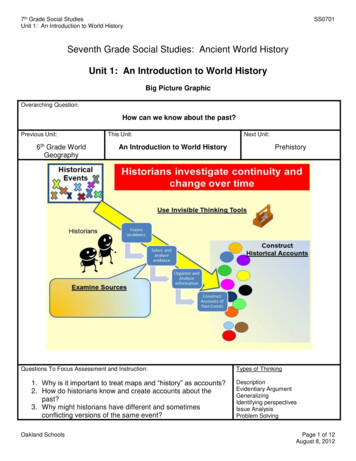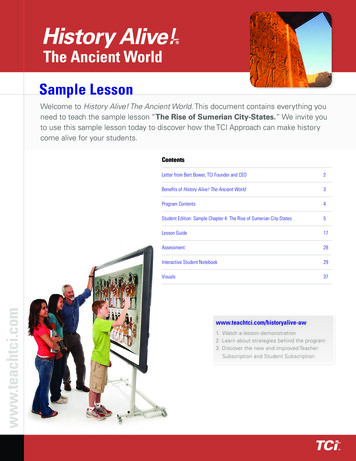
Transcription
Sample LessonWelcome to History Alive! The Ancient World. This document contains everything youneed to teach the sample lesson “The Rise of Sumerian City-States.” We invite youto use this sample lesson today to discover how the TCI Approach can make historycome alive for your students.www.teachtci.comContentsLetter from Bert Bower, TCI Founder and CEO2Benefits of History Alive! The Ancient World3Program Contents4Student Edition: Sample Chapter 4: The Rise of Sumerian City-States5Lesson Guide17Assessment28Interactive Student w1. Watch a lesson demonstration2. Learn about strategies behind the program3. Discover the new and improved TeacherSubscription and Student Subscription
Welcome!H i s to ry A l i ve! T h e A n c i e n t Wo rl dWelcome to the second edition of History Alive! The Ancient World, whichis a part of TCI’s engaging middle school social studies series. Since theprogram was first released, I’ve been slipping into classrooms with my camera tocatch the TCI Approach in action. Despite the great diversity of classes in whichthe images were taken—in urban and suburban settings, in mainstream andEnglish Language Development classes, with honors and special educationstudents—one similarity always strikes me: students are actively involved inhistory and having a great time.Our goal in creating History Alive! The Ancient World was to engage students’multiple intelligences, connect history to their own lives, and foster criticalthinking. The result has been a movement away from traditional, teacher-centeredclassrooms to more engaging, active social studies instruction. Improved testscores, student enthusiasm for history, and teacher renewal have followed.I encourage you to try this sample lesson from History Alive! The Ancient Worldwelcomewith your students today. And I’d love one day to receive a photo of your students2in action, totally absorbed in the study of history.Welcome to the growing TCI community of inspired, active social studies teachers!Best,Bert BowerTCI Founder and CEO
Benefits of History Alive! The Ancient World support language arts instruction in thesocial studies curriculum with reading,writing, speaking, and listening activities,as well as Reading and Writing Toolkits. use Enrichment Resources to helpstudents extend learning beyond thelessons, including biographies, literature,primary sources, Internet projects andlinks, and essays related to ancientworld history. incorporate Quicker Coverage and DeeperCoverage suggestions to adjust the paceand depth of instruction.The TCI program promotes historicalcuriosity and empathy, as studentsstep back in time to visit ancientcivilizations and make connections withtheir current lives. For example, students travel with early hominids as they movefrom hunting and gathering to farming. excavate a Shang dynasty tomb to learnabout this early civilization’s government,social structure, art, and technology.benefits tour Athens during its Golden Age.3History Alive! The Ancient World was createdby teachers, for teachers. The program isflexible and easy to use, providing a varietyof ways to meet diverse student needs andcurriculum configurations. Teachers can modify instruction for English languagelearners, learners reading and writingbelow grade level, learners with specialeducation needs, and advanced learners.This newest edition includes many featuresto make ancient world history come alivefor students. Setting the Stage sections at thebeginning of each unit orient studentsto the physical and human geographyof what’s to come. Geography Challenge activitiescomplement Setting the Stage by askingstudents to apply both geography andcritical thinking skills. Reading Further sections provide highinterest case studies that drill down intointeresting events, concepts, and peoplediscussed in the chapter. Timeline Challenge activities at the endof each unit highlight key events, people,and places and ask students to apply bothchronology and critical thinking skills.History Alive! The Ancient World will helpyou ignite your students’ passion forhistory—and re-ignite your passion forteaching it!H i s to ry A l i ve! T h e A n c i e n t Wo rl dHistory Alive! The Ancient World introduces students to the beginnings of the humanstory. As they explore the early civilizations of Egypt and the Middle East, India, China,Greece, and Rome, students discover the greatness of these ancient cultures and howthey continue to influence the modern world.
Welcome!Program Contents7 Geography and the EarlySettlement of Egypt, Kush, andCanaanIn History Alive! The Ancient World,an Essential Question organizeseach chapter and its correspondingactivity. By reading the StudentEdition and participating in theclassroom activity, students gain adeeper understanding of the content.Unit 5: Ancient Greece25 Geography and the Settlementof Greece26 The Rise of Democracy8 The Ancient Egyptian Pharaohs27 Life in Two City-States: Athensand Sparta9 Daily Life in Ancient Egypt28 Fighting the Persian Wars10 The Kingdom of Kush29 The Golden Age of Athens11 The Origins of Judaism30 Alexander the Great and HisEmpire12 Learning About WorldReligions: Judaism31 The Legacy of Ancient GreeceUnit 3: Ancient IndiaUnit 6: Ancient Rome13 Geography and the EarlySettlement of India32 Geography and the EarlyDevelopment of Rome14 Unlocking the Secrets ofMohenjodaro33 The Rise of the RomanRepublicUnit 1: Early Humans and the Riseof Civilization15 Learning About WorldReligions: Hinduism34 From Republic to Empire1 Investigating the Past16 Learning About WorldReligions: Buddhism2 Early Hominids3 From Hunters and Gatherersto Farmers4 The Rise of SumerianCity-States17 The First Unification of India18 The Achievements of theGupta Empire5 Ancient SumerUnit 4: Ancient China6 Exploring Four Empires ofMesopotamia19 Geography and the EarlySettlement of China20 The Shang Dynasty35 Daily Life in the Roman Empire36 The Origins and Spread ofChristianity37 Learning About WorldReligions: Christianity38 The Legacy of Rome in theModern WorldF R E E 3 0 DAY T R I A L21 Three Chinese Philosophies22 The First Emperor of China23 The Han DynastySample Lesson:4 The Rise of SumerianCity-States24 The Silk RoadTest-drive with a 30 Day TrialWith the Teacher Subscription, teachers can get anentire class interacting with one computer, an internetconnection and a projector. Students thrive on theimmediate feedback they get using the StudentSubscription’s Reading Challenges.www.teachtci.com/trial4H i s to ry A l i ve! T h e A n c i e n t Wo rl dUnit 2: Ancient Egypt and theMiddle East
Stu d e n t E d i ti o n L e s s o n G u i d e L e s s o n M a s te rs I n te ra c ti ve Stu d e n t N o te b o o kChapter 4The Rise of SumerianCity-StatesHow did geographic challenges lead to the riseof city-states in Mesopotamia?4.1 Introduction From Caves to City-States2 Million B.C.E. VisualsIn Chapter 3, you learned how people in the Fertile Crescentbegan farming and living in small villages. In this chapter, you’llsee how small Neolithic villages grew into large, complex cities.These villages were located in a land of rolling hills and lowplains called Mesopotamia (meh-suh-puh-TAY-mee-uh). Thisland is in modern-day Iraq. Mesopotamia is a Greek word thatmeans the “land between the rivers.” These two main rivers ofthe Fertile Crescent are the Tigris (TIE-gruhs) River and theEuphrates (yuh-FRAY-teez) River. Cities first appeared in thesouthern part of this land.The earliest cities in this area date back to about 3500 B.C.E.These first cities were like small, independent countries. Theyeach had their own ruler, as well as their own farmland whichprovided food. Suppose that you were visiting one of these earlycities. You would see a walled settlement surrounded by farmland used to supply food for the city. You would see strong citywalls built of sunbaked bricks. Moats, or ditches filled with water,would surround these walls and help keep out enemies. Duringan attack, people living outside the city walls would flee insidefor protection.As you gazed at the city, you might wonder how it came to bebuilt. Why didn’t people in Mesopotamia go on living in smallvillages, as their ancestors had done for thousands of years? Whydid large city-states grow in the “land between the rivers”? Inthis chapter, you’ll find out.1,750,000 B.C.E.61 Million B.C.E.Paleolithic Age2 Million to8000 B.C.E.500,000 B.C.E.10,000 B.C.E.1 B.C.E.Enlarged Section10,000 to 1 B.C.E.NeolithicAge8000-3000B.C.E.10,000 B.C.E.5,000 B.C.E.SumerianCity-States3500-2300B.C.E.1 B.C.E.These ruins in the Syrian Desert reveal an ancient Sumerian walled city.The Rise of Sumerian City-StatesDraft33
times, the geographic arealocated between the Tigrisand Euphrates riversTigris River one of the twolargest rivers in SouthwestAsia that flow from themountains in Turkey to thePersian GulfEuphrates River one ofthe two largest rivers inSouthwest Asia that flow frommountains in Turkey to thePersian GulfOver time, Mesopotamians found solutions to these fourproblems. Let’s explore how their solutions led to the buildingof some of the first cities in the world.Mesopotamia, About 2500 B.C.E.25 ECatalHoyukCaspianSeaSTAURUS MOUNTAINN i le0erRivAW SE 04-2a.epsDraftThird ProofTCI18 020200200400 miles400 kilometersLambert Conformal Conic ProjectionAncient Mesopotamia, About 2500 B.C.E.BlackChapterCyan TAINMJordan 35 E30 E35 NMSFertile CrescentSumerModerncoastline50 EPersianGulfNeolithic farmingcommunitySumerian city-state55 E VisualsGeographic features such as theclimate, the Zagros Mountains,and the Tigris and Euphratesrivers affected where peoplesettled in Mesopotamia.It was not easy to live in the part of the Fertile Crescent calledMesopotamia. The northern part was hilly and received rain.The southern part had low plains, or flat land. The sun beatdown fiercely on the plains between the Tigris River and theEuphrates River. There was little rain. The Mesopotamianswere farmers, and their farms needed water. The rivers broughtwater to the plains in flood season, but for most of the year thesoil was hard and dry.On the plains, building materials were difficult to find. Therewere plenty of reeds (weeds that grow near rivers). But there werefew trees to provide wood. Even stones were scarce. And therewere few natural barriers to keep out enemies.Mesopotamians faced four major problems as they tried tosurvive in this environment: food shortages in the hills an uncontrolled water supply on the plains difficulties in building and maintaining systems thatprovided water across village boundaries attacks by neighboring communities Stu d e n t E d i ti o n L e s s o n G u i d e L e s s o n M a s te rs I n te ra c ti ve Stu d e n t N o te b o o k4.2 Mesopotamia: A Difficult EnvironmentMesopotamia in ancient7
Stu d e n t E d i ti o n L e s s o n G u i d e L e s s o n M a s te rs I n te ra c ti ve Stu d e n t N o te b o o kYou learned in the last chapter that, in Neolithic times, people insome areas of the world began farming. The rolling foothills ofthe Zagros (ZAH-grihs) Mountains in northern Mesopotamiawas one of these areas.Mild weather and plentiful rains made the foothills a goodplace to farm. The wooded hills provided timber for buildingshelters. There were plenty of stones in the hills for toolmaking.Over several thousand years, these good conditions allowed thenumber of people in Mesopotamia to grow dramatically.Then problems arose. Some historians believe that by 5000B.C.E., farmers in the Zagros foothills did not have enough landto grow food for the increasing population. As a result, villagesbegan to suffer from food shortages.Below the foothills and to the south, the Euphrates and Tigrisrivers ran through flat plains. The plains covered a large area ofland, and few people lived there. During most of the year, theland was very hard and dry. And the plains lacked trees andstones for making shelters and tools.Yet, the plains held promise, too. In the spring, both of therivers flooded, bringing precious water to the land. Perhapsfarms could be successful there.Driven by the need to grow food, people moved out of thefoothills and onto the plains. This region became known asSumer (SOO-mer), and its people, the Sumerians.DraftThe Zagros foothills were an idealplace to farm. Visuals4.3 Food Shortages in the Hills8Sumer an area in southernMesopotamia, where citiesfirst appearedThe Rise of Sumerian City-States35
4.4 Uncontrolled Water Supply in theRiver Valleysupplying land with waterlevee a wall of earth built toprevent a river from floodingits banks36Chapter 4Draft Visualsirrigation a means ofThe farmers who moved to Sumer faced many challenges. Oneof the biggest problems was the uncontrolled water supply.During the spring, rain and melted snow from the mountains flowed into the Tigris and Euphrates rivers, causing themto flood across the plains. But no one could be sure exactly whenthe floods would come. If it happened after farmers planted theircrops, the young plants would be washed away.For much of the rest of the year, the sunbaked soil was dryand hard as stone. Hot, strong winds blew thick layers of dustacross the ground.Faced with such dramatic seasonal changes, farmers had toconstantly struggle to raise crops. They had either too little ortoo much water. To grow food, they needed a way to control thewater so they would have a reliable water supply all year round.Therefore, Sumerian farmers began to create irrigationsystems for their fields. They built levees along the sides of theriver to prevent flooding. When the land was dry, the farmerspoked holes in the levees. The water flowed through the holesand into the thirsty fields.Over time, the Sumerians learned other ways to control thesupply of water. They dug canals to shape the paths the watertook. They also constructed dams along the river to block thewater and force it to collect in pools they had built. These pools,or reservoirs, stored the water for later use. Stu d e n t E d i ti o n L e s s o n G u i d e L e s s o n M a s te rs I n te ra c ti ve Stu d e n t N o te b o o kThe Euphrates is the longestriver in Southwest Asia.9
Stu d e n t E d i ti o n L e s s o n G u i d e L e s s o n M a s te rs I n te ra c ti ve Stu d e n t N o te b o o k4.5 Building and Maintaining a ComplexIrrigation SystemDraftsilt fine particles of rock VisualsIrrigation systems provided enough water for Sumerian farmersto grow plenty of food. But a new problem arose: how to maintain the irrigation system across village boundaries.The irrigation system passed through a number of villagesas it carried water from the river to the fields. The system neededconstant care and repair. Canals became clogged with silt, sofarmers had to clean them regularly. One clogged canal coulddisrupt the entire system.Since villages were connected for miles around by thesecanals, farmers could no longer live apart, or in small groups.They had to work together for the common good.Gradually, villages came to depend on one another to buildand maintain this complex irrigation system. People who lived indifferent villages may have worked together to clear the silt fromthe canals to keep them open. Workers may have scooped waterfrom one reservoir into another to ensure that water levels werebalanced. As the Sumerians worked together, they began tocreate larger communities. Between 3500 and 3000 B.C.E.,villages grew into towns. Some towns in Sumer became citieswith populations as large as several thousand people.The Euphrates River still irrigatesfields in Iraq today.The Rise of Sumerian City-States3710
4.7 From Small Farming Villages to LargeCity-Statescity-state an early city thatwas like a small, independentcountry with its own laws andgovernment38Chapter 4DraftAs you’ve seen, beginning around 3500 B.C.E., the Sumeriansprogressed from living in small farming villages to buildinglarge, walled cities. How and why did this happen? The answerlies not only in the problems the Sumerians faced, but also intheir solutions. A basic challenge for any group of people is howto provide food for itself. Food shortages had forced settlers inMesopotamia to move from the foothills down to the rivervalley. There, farmers faced the problem of having either toomuch water or too little. VisualsA stele (STEE-lee) is an uprightslab of stone inscribed with lettersand pictures to depict importantevents. This part of the Stele of theVultures, which was found in Iraq,shows an attacking army.As Sumerian cities grew, they fought overthe right to use more water. Sometimes,people in cities located upriver (closer towhere the river begins) built new canalsor blocked other cities’ canals. In thisway, they kept water from reaching thecities that were downriver (farther fromwhere the river begins). Disputes overwater became so intense that they oftenled to bloodshed.The Sumerians looked for ways toprotect their cities from neighboringcommunities. The plains provided nonatural barriers. There were no mountain ranges or rushing rivers to keep outenemies. The Sumerians began to buildstrong walls around their cities. Theyconstructed the walls out of mud bricksthat were baked in the sun until hard.The Sumerians also dug moats outsidecity walls to help prevent enemies fromentering their cities. Most people lived in houses within thewalled cities, but the farms lay outside. In case of attack, farmersfled the fields for safety inside the city walls.The walled cities of Sumer were like independent countries.Historians call them city-states. By about 3000 B.C.E., mostSumerians lived in city-states. Stu d e n t E d i ti o n L e s s o n G u i d e L e s s o n M a s te rs I n te ra c ti ve Stu d e n t N o te b o o k4.6 Attacks by NeighboringCommunities11
12Chapter SummaryIn this chapter, you have learned how geographic challenges led to the rise ofcity-states in Mesopotamia.Food Shortages in the Hills A shortage of food forced people to move from thefoothills of the Zagros Mountains to the plains between the Tigris and Euphratesrivers. This plains area became Sumer.Controlling Water Supply on the Plains Farmers in Sumer faced times of floodingand drought. They built irrigation systems to create a steady water supply. Maintaining these complex systems required cooperation among villages.From Farming Villages to City-States As villages grew into towns and cities, somebecame large city-states with protective walls around them.Draft VisualsA Sumerian city-state was like atiny country. Its surrounding wallshelped protect the city againstenemies. Stu d e n t E d i ti o n L e s s o n G u i d e L e s s o n M a s te rs I n te ra c ti ve Stu d e n t N o te b o o kTo control the water supply, Sumerians built a complexirrigation system. The system crossed village boundaries, so theSumerians had to cooperate with one another. This led them tolive in larger communities—the first cities.These city-states were like independent countries. Often, theyfought with one another. To defend themselves, the Sumeriansbuilt walls and dug moats around their cities. By 3000 B.C.E.,the solutions to the challenges faced by the Sumerians hadtransformed Sumerian farming villages into walled city-states.The Rise of Sumerian City-States39
Detecting the Past:Clues from ArchaeologySuppose that you are standing in the desert, southwest ofthe present-day city of Baghdad in Iraq. In the distance tothe east, you see the Euphrates River. To the west are milesof desert. You then notice that scattered on the ground aresmall mounds of dirt. What could have made these mounds?Woolley and His Team BeginIn general, archaeologists work in three stages. Woolley had justcompleted the first stage—Learn and Plan. He was now ready tobegin the second stage—Dig and Discover. “The first thing thatI did,” he wrote in 1922, “was to dig trial trenches . . . [to] give ussome idea of the layout of the city.”Draft40Chapter 4 VisualsBritish archaeologist LeonardWoolley worked like a real-lifedetective to reveal the secrets ofthe ancient city of Ur.Leonard Woolley asked that same question in 1922 when he began excavating the ancient city of Ur in Mesopotamia. Woolleywas a British archaeologist who had been trained to work muchlike a detective. His excavations and discoveries in Mesopotamia,between 1922 and 1934, tell a real-life detective story.For an archaeologist working in the early 1900s, Woolley’sapproach was unusually careful and scientific. Many archaeologists of that time viewed research as an adventure, not as ascience. They often dug up sites to search for treasure, more thanto gain knowledge. They made little effort to preserve the sitesor to prevent them from being damaged. These archaeologistsoften handed over artifacts to museums and private collectors inexchange for fame and money.Woolley, on the other hand, wrote that his goal was “to gethistory, not to fill museum cases, . . . and [that] history could notbe got unless both we and our men were duly trained.” Therefore,he excavated using a basic plan. In this way, he preserved eachclue that might help him understand life at Ur.By the time he arrived at Ur, Woolley had already studiedwhat others before him had found there. He knew where anancient temple had once stood, who had built it, and when theconstruction had begun and ended. But, most important, Woolley knew that the city in which the temple had stood was calledUr, and its people, the Sumerians. Stu d e n t E d i ti o n L e s s o n G u i d e L e s s o n M a s te rs I n te ra c ti ve Stu d e n t N o te b o o kReading Further13
VisualsWoolley dug deep trenches to discover how many generationsof people had lived at Ur. He and his team examined each stratum, or layer of earth, from the top to the bottom of the trench.When Woolley went down into the first trench, he foundmud-brick buildings at the shallowest, or most recent, layer.Slowly, he uncovered layer after layer, moving back in time. Atone point, the remains of the brick buildings disappeared. Next,he found reed huts.Excited by these early discoveries, the team continued to digin and around Ur. Each object, no matter how small, was considered important. As the team uncovered each layer of a trench,workers sifted the dirt. Others kept records of where objects werefound. These artifacts were labeled and packed carefully in boxes.14More DiscoveriesDuring the first four seasons, team members reached the bottomof the ziggurat, or temple area. They also explored other places.Slowly, one discovery at a time, a picture of Sumerian farminglife came together. The evidence showed that the Sumerians usedstone hoes to raise grain. They used grinding stones to grind thegrain into flour, which they used to make bread.In addition to these discoveries, the team found plaster madewith cow dung, which the Sumerians used to build their houses.Also found was a statue of a pig, indicating to the team that theSumerians had other farm animals.Draft Stu d e n t E d i ti o n L e s s o n G u i d e L e s s o n M a s te rs I n te ra c ti ve Stu d e n t N o te b o o kThe ziggurat, or temple area, of Urrises from the ruins of the ancientcity. Woolley carried out excavations of Ur from 1922 to 1934.The Rise of Sumerian City-States41
Woolley’s Most Famous Discovery42Chapter 4Draft VisualsThis is one of the deep pits Woolley and his team dug at Ur. Woolleyis one of the figures at the verybottom. His staff is standing alongthe steps and around the edge atthe top. Shown below is a gameboard discovered by Woolley andhis team.In their fifth season, Woolley and his team started to excavatetheir most famous discovery—a graveyard. They uncovered morethan 1,850 burial sites. Most of the burials dated from about2600 to 2500 B.C.E. The burial techniques were simple. Bodieswere wrapped in reed mats or put in clay coffins in small pits.This discovery made headlines all over the world. It was the firsttime that so many artifacts, including jewelry and weapons, hadbeen found in Mesopotamia.But the biggest discovery was yet to come. Woolley and histeam uncovered graves that contained great riches—the RoyalTombs of Ur. These tombs sometimes had more than one roomand contained many bodies surrounded by valuable objects.What Woolley found here would lead him to ask intriguing questions and to find startling answers.What did the tombs reveal? Woolley was able to identify thebodies buried in two of the graves. Near the bodies, writing wasfound on clay cylinder seals: “Mesdalamdug lugal,” or king, and“Puabi nin,” or queen. These burials had been grander. The bodies were discovered in rooms in deep holes. The chambers werebuilt of stone and had domed ceilings. The remains of jewelry,musical instruments, chariots, games, tools and weapons, andcups and jugs led the archaeologists to reach an interesting conclusion: the Sumerians must have believed in an afterlife. Thesewere objects the deceased would need in the afterlife.The team also uncovered ramps that led down into the tombs.All along the ramp and around the tomb were many other bodies. Woolley wondered why all these bodies were there. Theywere lined up as if the people had all gone to sleep. There werebroken cups by their sides. He reached a surprising conclusion. Itwas likely that these people had deliberately taken poison. Theylikely expected to go with their king or queen into the next life. Stu d e n t E d i ti o n L e s s o n G u i d e L e s s o n M a s te rs I n te ra c ti ve Stu d e n t N o te b o o kThe workers uncovered fish bones and the sinkers used todrop fishing nets to the river bottom. They discovered a claymodel of a boat, similar to one that Iraqis were still using inWoolley’s time. This indicated that the Sumerians ate fish andmade nets to catch them. Finally, the team found parts of aweaving loom, showing that the people of Ur knew how to makecloth.15
Stu d e n t E d i ti o n L e s s o n G u i d e L e s s o n M a s te rs I n te ra c ti ve Stu d e n t N o te b o o kWhat Happened After the Expedition?Back home, Woolley and the team would complete the finalstage of their work—Preserve, Reconstruct, and Interpret. Theyhad already packed and shipped artifacts back to museums.There, scientists would study, preserve, or reconstruct them, ifnecessary.What exactly would expensive jewelry from 4,500 years agolook like? One such puzzle was Queen Puabi’s headdress andjewelry. When the items were uncovered, they were lying on theground in pieces. They were made of gold, with lapis lazuli andcarnelian beads as decoration.First, the team photographed the jewelry and recorded exactly where each piece had been found in relation to the others.Then, the workers put them in boxes. Back in the lab, archaeologists pieced together the headdress. Team members also reassembled the queen’s necklaces and large hoop earrings.Woolley’s Legacy VisualsThe final step in an expedition is figuring out how to fit all theclues together. Woolley finished his work at Ur in 1934. For therest of his life, he wrote about what he had discovered at the siteand what he had learned.Here are Woolley’s major contributions toward our understanding of Sumerian life: The Sumerians were farmers andfishermen. They dug canals and irrigated their fields. They raisedanimals. They ground grain to make bread. They made cloth.They even took time to make statues of animals. They lived inplastered reed huts and, later, in mud-brick buildings.In addition, Wooley discovered clues that told him that theSumerians believed in an afterlife and were willing to die fortheir king or queen. They used a writing system, called cuneiform, to identify kings, conduct business, and describe Sumerianlife. They also created works of art and music.Leonard Woolley set the stage for careful and scientific theories about Mesopotamia that later archaeologists would furtherinvestigate and build on. In the 1960s and 1970s, the Iraqi government used Woolley’s research to reconstruct the Ur ziggurat.Woolley would likely have appreciated that. He truly believedthat present and future generations would better understandwho they were by knowing who had come before.16Woolley’s most important find wasthe grave of Queen Puabi. His teamfound the remains of her body. Thetop picture shows the gold headdress she was wearing, just as itwas when discovered in her grave.The bottom picture shows thereconstructed headdress.The Rise of Sumerian City-StatesDraft43
Stu d e n t E d i ti o n L e s s o n G u i d e A s s e s s m e n t I n te ra c ti ve Stu d e n t N o te b o o k R e s p o n s eC H A P T E RG r o u p4The Rise of SumerianCity-StatesHow did geographic challenges lead to the rise ofcity-states in Mesopotamia?OverviewMaterialsIn a Response Group activity, students learn how responses to geographicchallenges resulted in the formation of complex Sumerian city-states.History Alive!The Ancient WorldObjectivesVisualsInteractive StudentNotebooksVisuals 4A–4DIn the course of reading this chapter and participating in the classroom activity,students willCD Tracks 2–5Social Studies Vocabulary Developmenthandout (1 per student, oncolored paper) describe the location and physical setting of Mesopotamia, including theTigris and Euphrates river system. analyze geographic problems affecting ancient Mesopotamians and evaluatepotential solutions. describe how Mesopotamians modified their physical environment to solvegeographic problems.Lesson Mastersposter paper (2 sheets pergroup of 3)colored pencils or markers explain how the development of agricultural techniques, such as irrigationsystems, led to the emergence of Sumerian city-states.Language Arts support opinions with detailed evidence
History Alive! The Ancient World In History Alive! The Ancient World, an Essential Question organizes each chapter and its corresponding activity. By reading the Student Edition and participating in the classroom activity, students gain a deeper understanding of the content. Program Contents U

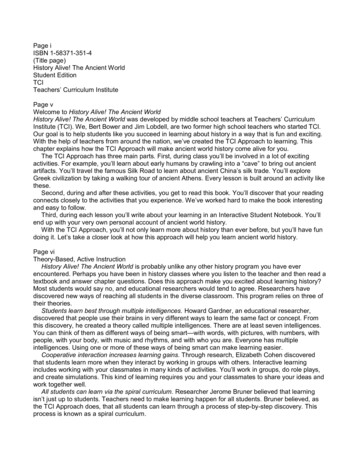


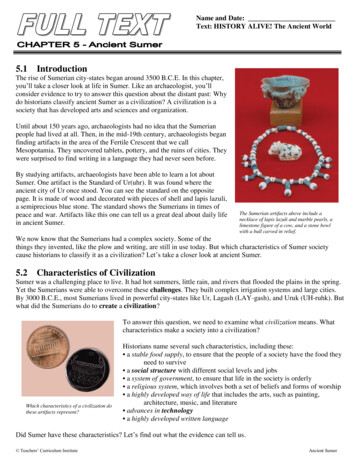
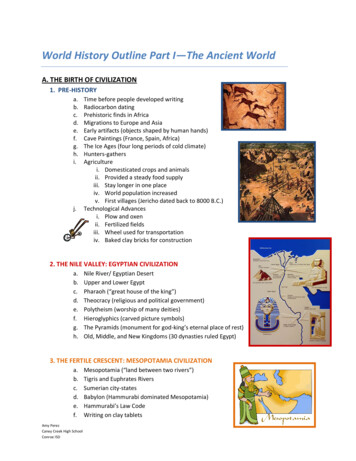



![History of Electronics electricity [Read-Only]](/img/18/history-20of-20electronics-20-20electricity.jpg)
